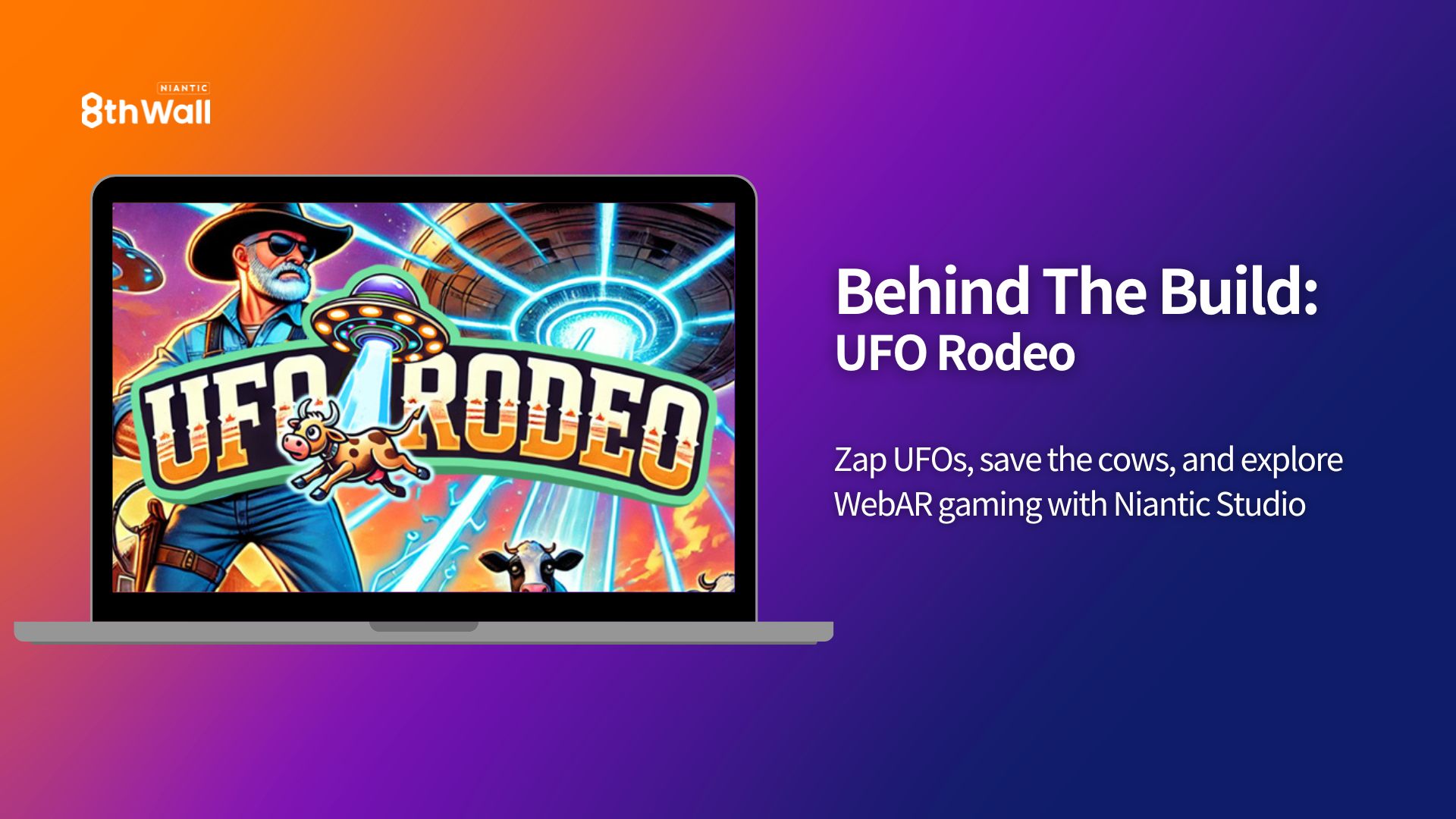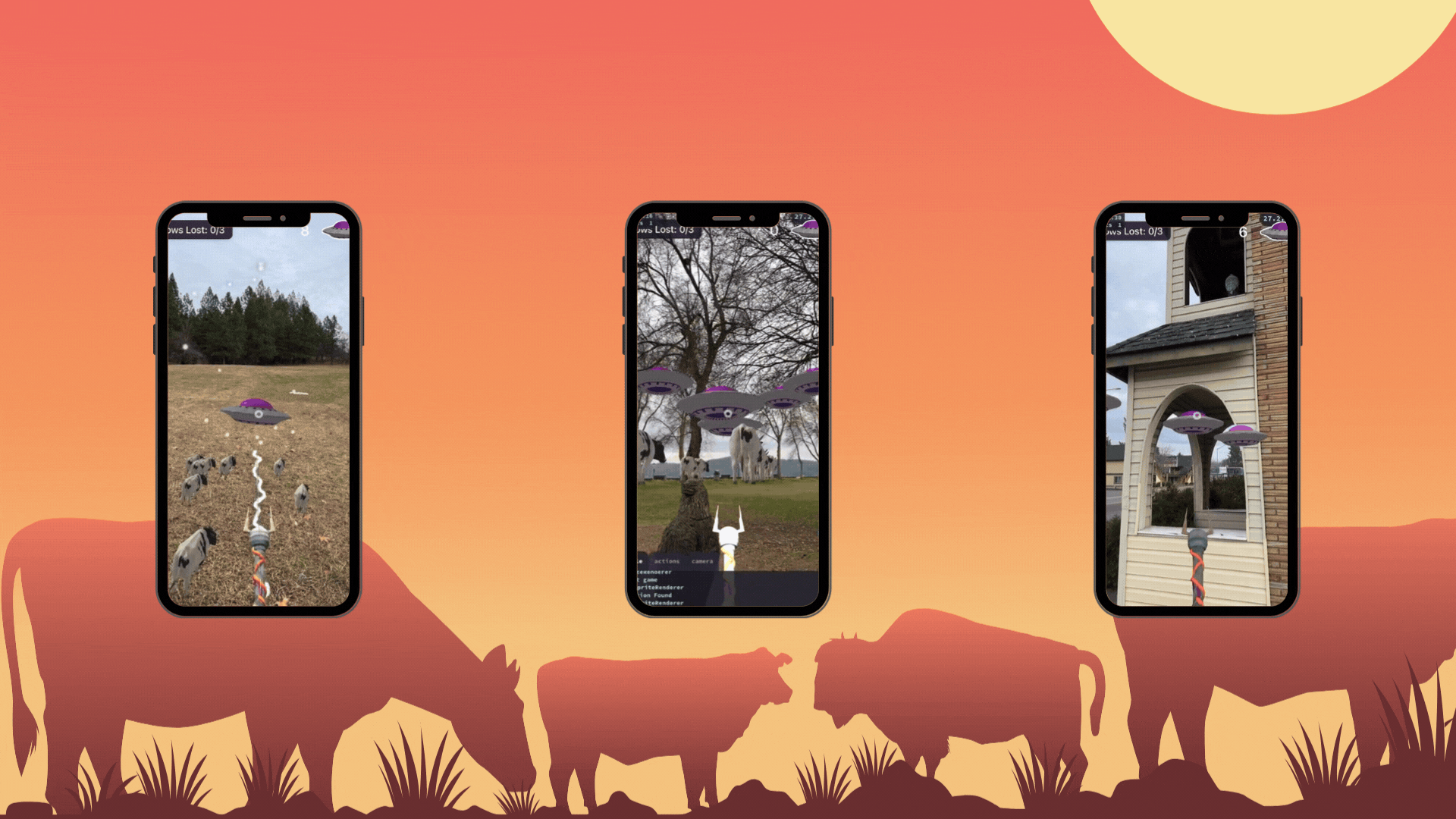8th Wall Blog
Behind the Build: Defend the ranch in UFO Rodeo
Zap UFOs, save the cows, and explore WebAR gaming with Niantic Studio

Tyler White’s UFO Rodeo is a fast-paced WebAR game where players must defend their cattle from incoming UFOs using a high-powered cattle prod. Set on a New Mexico ranch, this arcade-style experience immerses players in a sci-fi western showdown, blending physics-based interactions, real-time score tracking, and dynamic spawning systems. Built in Niantic Studio, UFO Rodeo leverages WebAR to create an engaging and interactive mobile game.
We spoke with Tyler about the development process and lessons learned while bringing UFO Rodeo to life.

What inspired you to create UFO Rodeo?
A love for UFO lore and the Niantic 8th Wall community. We were excited to use our phones as portals into the land of the phenomena.
How did Niantic Studio help bring your vision for this project to life? Were there specific tools or features that were essential?
Niantic Studio provided the visual, AR-forward game engine we needed to collaborate and build in real time. The physics colliders system was crucial in making our UFOs behave dynamically—ensuring they avoided running into each other and creating a more organic, playful feel.
Additionally, the supportive developer community around Niantic Studio played a huge role. Without the community and the generous support of the 8th Wall team, we would have faced far more challenges throughout development.
Were there any challenges along the way? How did you overcome them?
One of the biggest hurdles was data storage—we initially struggled with not being able to store objects or arrays in schema attributes and data attributes. We overcame this by storing global variables and using Niantic Studio’s built-in event system to communicate between components.
Another major challenge was UI implementation. We relied on custom HTML and CSS to hardcode our UI elements, which allowed us to create a clean and responsive interface.
We also heavily leaned on documentation, sample projects, and developer support to solve problems along the way. The improvements in documentation (shoutout to George!) and the ability to learn from other sample projects made a huge difference.
What were the main steps you took to make this project that would be helpful to share with other developers?
- Read the documentation – This is your best friend when building in Niantic Studio.
- Work with friends who are smarter than you – Collaboration and feedback can push your project further.
- Watch tutorial videos – The 8th Wall YouTube channel has invaluable guides.
- Clone other projects – Learn by exploring and reverse-engineering sample projects.
- Ask questions – Engage with the community, use the 8th Wall forum, and don’t be afraid to reach out.
What advice would you give other developers interested in building 3D web, real-world games or AR experiences with Niantic Studio?
- Watch the tutorial videos on 8th Wall’s YouTube channel and follow along with sample projects.
- Read the documentation and reference sample projects frequently.
- Ask questions – Join the 8th Wall community and Slack, and engage with fellow developers.
- Experiment – Clone projects and tweak the code to understand how different features work.
- Learn JavaScript – If you want to get more technical, taking a JavaScript bootcamp can help you understand object-oriented programming and improve your AR development skills.
Where do you see the future of AR going, and how does Niantic Studio fit into that vision?
The future of AR lies in better hardware—especially AR glasses—and in making development more accessible. Niantic Studio is at the forefront of this shift, allowing creators to build cross-platform experiences that work seamlessly across mobile devices and headsets.
The platform’s mission to make AR development accessible to everyone is key to driving the industry forward. By lowering barriers to entry, Niantic Studio empowers developers to create more immersive, interactive experiences for all.
Top Features in UFO Rodeo
- Dynamic score system: Tracks UFOs zapped, survival time, and overall performance.
- Physics-based UFO AI: Ensures that UFOs roam naturally and react dynamically to collisions.
- Spawning system: Keeps gameplay unpredictable by dynamically generating cows and UFOs.
- Responsive UI & audio feedback: Players receive real-time score updates and sound cues to enhance engagement.
- Fast-paced WebAR gameplay: No downloads—just jump into the action from your mobile browser.
Pro tips for developers inspired by Wall Bop
- Use physics colliders to create smarter, more interactive game objects.
- Leverage event-driven logic to communicate between different components.
- Experiment with dynamic spawning to keep gameplay fresh and exciting.
- Playtest often—real player feedback is invaluable in refining mechanics.
- Explore sample projects to learn best practices and optimize your development process.
.png)
Ready to defend the ranch?
UFO Rodeo showcases the power of Niantic Studio for building fast-paced, interactive WebAR games. Want to explore the mechanics behind the game? Clone Tyler White’s sample projects to learn more about score tracking, roaming entities, and spawning systems:
- Score System Sample – Learn how to implement real-time score tracking.
- Roaming Entities System – Build roaming AI for dynamic object behavior.
- Spawning System Tutorial – Implement an automated entity spawning system.
Start building, start zapping, and let UFO Rodeo inspire your next great WebAR experience! Want to build your own out-of-this-world experience? Create your free Niantic Studio account now and start building!
.png)